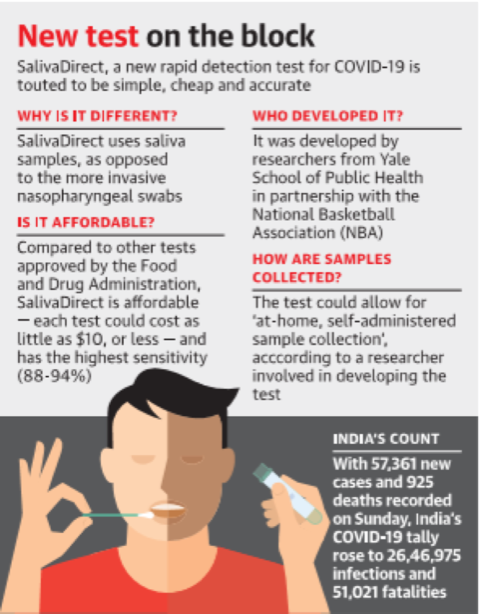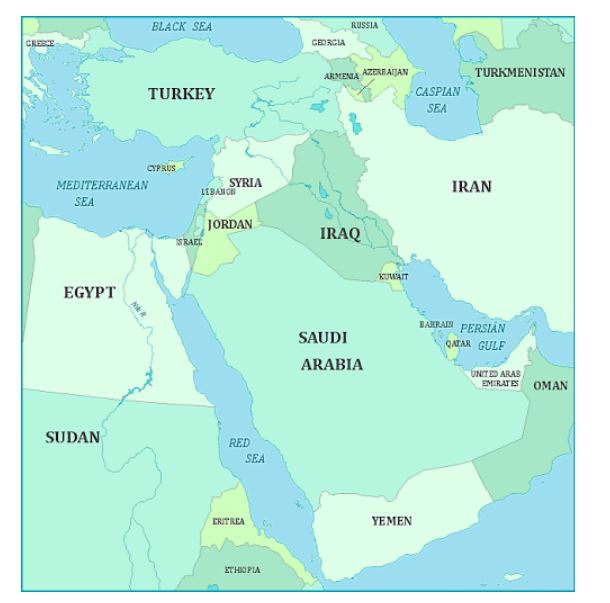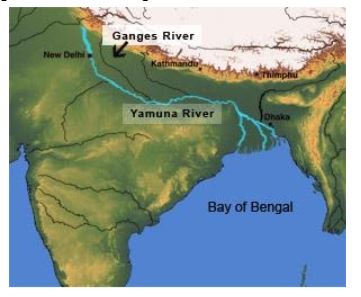IASbaba's Daily Current Affairs Analysis

Archives
(PRELIMS + MAINS FOCUS)
SalivaDirect test
Part of: GS Prelims and Mains II- Health issue
Context: On August 16, 2020, the United States Food and Drugs Administration authorised the emergency use of saliva based diagnostic test for COVID-19.About SalivaDirect test.
About SalivaDirect test
- SalivaDirect test is an inexpensive test, developed by a team from the Yale School of Public Health, has high sensitivity and can detect the virus even when the number of virus copies in the saliva sample is as low as 612 copies per microlitre.
- Collecting and testing saliva samples involves three steps — collecting saliva without preservative buffers, proteinase K treatment and heat inactivation, and dualplex RTqPCR virus detection.
- Disadvantages in previously using Nasopharyngeal swabs is it leads to false negative results due to errors at the time of sample collection.
- The sensitivity of the new SalivaDirect test was about 93%, according to a preprint posted on medRxiv “Official data shows 88-94% [sensitivity]” which is the best accuracy rate( sensitivity) of any saliva test as tweeted by Andy Slavitt, a former acting administrator of the Centres for Medicare and Medicaid Services in the Obama administration.

Pic source: The Hindhu
Animal Welfare Board of India (AWBI)
Part of: GS Prelims and GS-III – Environment
Context: The Delhi High Court has asked the Animal Welfare Board of India (AWBI) to conduct physical survey of all circuses in the country to verify the condition of animals being kept there.
Animal Welfare Board of India (AWBI)
- It is a statutory body
- It is an advisory body advising the Government of India on animal welfare laws, and promotes animal welfare in the country of India.
- The Animal Welfare Board of India was established in 1962 under Section 4 of The Prevention of Cruelty to Animals Act,1960.
- The Board consists of 28 Members, who serve for a period of 3 years.
- It works to ensure that animal welfare laws in the country are followed and provides grants to Animal Welfare Organisations.
- The Board was initially within the jurisdiction of the Government of India’s Ministry of Food and Agriculture. In 1990, the subject of Prevention of Cruelty to Animals was transferred to the Ministry of Environment and Forests, where it now resides.
- It frames a range of rules on how animals ought to be humanely treated everywhere. It has also frequently litigated to have stricter laws to ensure animals were not unduly harassed or tortured.
- HQ shifted to Ballabhgarh in Faridabad District of Haryana from Chennai, Tamil Nadu
PM-CARE
Part of: GS Prelims and GS-II Governanace
Context: PMO denies RTI plea seeking info on PMCARES
About PM-CARES
PM-CARES Fund was set to accept donations and provide relief during the Covid-19 pandemic, and other similar emergencies.
PM-CARES Fund
- PM-CARES was set up as a public charitable trust with the trust deed registered on March 27, 2020.
- It can avail donations from the foreign contribution and donations to fund can also avail 100% tax exemption.
- PM-CARES is different from the Prime Minister’s National Relief Fund (PMNRF).
Composition:
- Prime Minister as chairperson
- Defence Minister, Home Minister, Finance Minister
- Three trustees nominated by the Prime Minister “who shall be eminent persons in the field of research, health, science, social work, law, public administration and philanthropy”.
- Prime Minister’s National Relief Fund (PMNRF)
Important value additions:
PM-CARES Not a Public Authority: It has been stated that the PM-CARES Fund is not a Public Authority under the ambit of Section 2(h) of the RTI Act, 2005.
UAE, Israel establish direct phone service after deal
Part of: GS Prelims and GS-II – International Relations; Bilateral agreements
Context: The Israeli and UAE Foreign Ministers inaugurated on Sunday direct phone services between the two countries in their first announced call after an peace agreement to normalise relations, said an Emirati official.

Image source: Here
- The UAE has become the first Gulf Arab state to do so and only the third Arab nation to have active diplomatic ties with Israel.
Impact on the UAE:
- The deal smoothens the UAE’s international campaign to be seen as a beacon of tolerance in the Middle East despite being governed by autocratic rulers.
- It puts the UAE out first in a regional recognition race among neighbouring Gulf Arab states.
Impact on Israel:
- The announcement justifies the year-long claims of Israeli Prime Minister Benjamin Netanyahu that his government enjoys closer ties to Arab nations than publicly acknowledged.
- The deal gives Netanyahu a domestic boost at a time when Israel’s coalition government is facing infighting and the possibility of early elections.
Important value additions:
- Under the deal, Israel would suspend its plans to annex large parts of the occupied West Bank.
- The West Bank is sandwiched between Israel and Jordan. One of its major cities is Ramallah, the de facto administrative capital of Palestine.
- Israel took control of it in the Six-day Arab-Israeli war, 1967 and has over the years established settlements there.
- A joint statement from the USA, the UAE and Israel has been issued which says that delegations would meet in the coming weeks to sign deals on direct flights, security, telecommunications, energy, tourism and health care.
- Both nations will also partner on fighting the Covid-19 pandemic together.
- It remains unclear what prompted Israel and the UAE to make the announcement now.
- In June 2020, the UAE’s ambassador to the USA warned that Israel’s plan to annex the Jordan Valley and other parts of the occupied West Bank would upend Israel’s efforts to improve ties with Arab nations.
Miscellaneous
Peron in news
IAS ASHISH CHAUHAN
- Spain mountain peak named after uttarakhand’s ias officer dr ashish – virgin mountain peak of spain named of uttarakhand ias officer dr ashish chauhan
- Spanish mountaineer Antonio has named the virgin peak in Spain as ‘Magistrate’s Point’ after the Spanish mountaineer summits
- Antonio has dedicated the achievement to the former Uttarkashi collector for his humane gesture for helping him during his summit to Mt Satopanth in 2018, where he had stuck amid climbing the peak
Yamuna River
- Yamuna River is largest tributary of Ganga River, while Bangladesh’s Jamuna River is largest distributary channel of the Brahmaputra River. Yamuna is another sacred river of India that origins from Yamunotri
- From Uttarakhand, Yamuna River flows for some 200 kilometers in Lower Himalayas and Shivalik Ranges.
- Its largest tributary Tons River flows through Garhwal region in Uttarakhand, and meets Yamuna near Dehradun.
- Along with Ganga to which run almost parallel after it touches the Indo-Gangetic plain and creates the Ganga-Yamuna Doab region.

Image source: Here
(MAINS FOCUS)
GOVERNANCE/ ECONOMY/ SCIENCE & TECH
Topic: General Studies 2:
- Issues relating to development and management of health
- e-governance- applications, models, successes, limitations, and potential
National Digital Health Mission
Context: During the Independence Day Speech, PM Modi launched the National Digital Health Mission and said that the initiative which is completely technology based will revolutionise the health sector in India
What is the basic idea of NDHM?
- By Digital Health Infrastructure created by NDHM,instead of ferrying medical records in polythene bags from doctor to doctor, Indians will be able to access their lab reports, x-rays and prescriptions irrespective of where they were generated, and share them with doctors or family members — with consent.
What are the key features of NDHM?
- Six key building blocks or digital systems namely, HealthID, DigiDoctor, Health Facility Registry, Personal Health Records, e-Pharmacy & Telemedicine
- Unique Health ID: Every Indian under the mission would get an ID card containing all relevant information about his/her medical conditions and treatments, tests etc
- Comprehensive Health Profile: Ranging from doctor appointment to the medication prescribed, medical tests, every bit of detail will be available in the health profile of an individual across public and private healthcare.
- National Health Authority (NHA), the attached office of the Ministry of Health & Family Welfare has been given the mandate to design, build, roll-out and implement the NDHM in the country.
- Encouraging Private Players for promotion of Health Data Analytics &Medical Research
- Private stakeholders will have an equal opportunity to integrate with these building blocks and create their own products for the market.
- However, core activities and verifications, for example, generation of Health ID or approval of a doctor/facility shall remain with the government.
-
- Additional components, like Personal Health Record (PHR) and Electronic Medical Record (EMR) solutions can be developed by private players in line with the guidelines that will be issued.
Merits of NDHM
- CreatesDigital Health Ecosystem:It will reduce the existing gap between various stakeholders such as doctors, hospitals and other healthcare providers by bringing them together and connecting them in an integrated digital health infrastructure.
- Voluntary Scheme: The NDHM is a holistic, voluntary healthcare programme. While option of digital Health ID will be there, in case a person does not want Health ID, then also treatment needs to be provided.
- Data Safeguards: All products by private participants shall be as per official guidelines taking care of security, privacy and standards of the NDHM ecosystem
- Improves Healthcare Service Efficiency:The created Digital Health infrastructure enables users to obtain a longitudinal view of their healthcare records. Electric Medical Records will increase accountability, improves patient outcomes, and advances evidence-based policymaking.
- Addresses Healthcare Challenges: The Digital Healthinfrastructuregreatly reduces the risk of preventable medical errors and significantly increase quality of care.
- Reduces Information Asymmetry: The Digital datawill empower all Indians with the correct information and sources enabling them to take an informed decision to avail the best possible healthcare.
- Aligned with International Goals: NDHM will be a major stride towards achievement of the United Nations Sustainable Development Goal 3.8 of Universal Health Coverage, including financial risk protection
- Last Mile Connectivity Issue: The provision of promoting e-pharmacy & Telemedicine will enable people in rural areas access quality healthcare providers.
- Data Ownership issues addressed:
- The health data will reside at individual hospital servers in a federated architecture.
- Citizen will own his/ her health data and would require consent to share data.
- All the basic registries of patients/hospital/medical professionals that enable data sharing will be owned by a government entity.
Challenges Ahead
- Cannot be a Substitution: Digitalisation is welcome but is no substitute for inadequate human resources and infrastructure in the health sector.
- Doesn’t address core concern of Health care sector:The real issue in India’s health sector is the abject lack of primary health facilities in much of India.
- Digital awareness about the utility of the scheme is needed for its successful adoption by beneficiaries so that it eases the process and not
- To enable seamless data exchange, all users (pharmacists, laboratories, radiology clinics, insurers and hospitals) must be incentivised to adopt a standard language of communication
Did You Know about similar project by UK?
- In 2005, the UK’s National Health Service (NHS) started deployment of an electronic health record systems with a goal to have all patients with a centralised electronic health record by 2010.
- While several hospitals acquired electronic patient records systems as part of this process, there was no national healthcare information exchange.
- The project had been beset by changing specifications, technical challenges and clashes with suppliers, which left it years behind schedule and way over cost.
- The program was ultimately dismantled after a cost to the UK taxpayer was more than £12 billion, and is considered one of the most expensive healthcare IT failures.
SOCIETY/ GOVERNANCE
Topic: General Studies 1,2:
- Issues of women and Social Empowerment
- Laws, institutions and Bodies constituted for the protection and betterment of these vulnerable sections
Minimum age of marriage for women
Context: During the Independence Day Speech, PM announced that the central government has set up a committee to reconsider the minimum age of marriage for women
Do You Know?
- Currently, the law prescribes that the minimum age of marriage for men as 21 years and 18 and for women as 18 years.
- The minimum age of marriage is distinct from the age of majority which is gender-neutral. An individual attains the age of majority at 18 as per the Indian Majority Act, 1875
What is the committee that the Prime Minister mentioned in his speech?
- On June 2, the Union Ministry for Women and Child Development set up a task force to examine matters pertaining to age of motherhood, lowering Maternal Mortality Ratio and the improvement of nutritional levels among women
- The task force will examine the correlation of age of marriage & motherhood with health, medical well-being, nutritional status of the mother& child
- Headed by former Samata Party president Jaya Jaitely, the committee includes Member Health at the NITI Aayog, Dr Vinod Paul, and several Secretaries to the Government of India.
Why is there a minimum age for marriage?
- The law prescribes a minimum age of marriage to essentially outlaw child marriages and prevent the abuse of minors.
- Personal laws of various religions that deal with marriage have their own standards, often reflecting custom
- For Hindus, Section 5(iii) of The Hindu Marriage Act, 1955, sets 18 years as the minimum age for the bride and 21 years as the minimum age for the groom.
- However, child marriages are not illegal — even though they can be declared void at the request of the minor in the marriage.
- In Islam, the marriage of a minor who has attained puberty is considered valid.
- The Special Marriage Act, 1954 and the Prohibition of Child Marriage Act, 2006 also prescribe 18 and 21 years as the minimum age of consent for marriage for women and men respectively.
- Additionally, sexual intercourse with a minor is rape, and the ‘consent’ of a minor is regarded as invalid since she is deemed incapable of giving consent at that age
How has the law evolved over years?
- The Indian Penal Code enacted in 1860 criminalised sexual intercourse with a girl below the age of 10.
- A legal framework for the age of consent for marriage in India only began in the 1880s.
- The provision of rape was amended in 1927 through The Age of Consent Bill, 1927, which declared that marriage with a girl under 12 would be invalid.
- In 1929, The Child Marriage Restraint Act set 16 and 18 years as the minimum age of marriage for girls and boys respectively. This law,
- It was eventually amended in 1978 to prescribe 18 and 21 years as the age of marriage for a woman and a man respectively.
How did freedom movement deal with these laws?
- Conservative Stance: The laws faced opposition from conservative leaders of the Indian National Movement, who saw the British intervention as an attack on Hindu customs.
- Progressive Stance: However, there were other who propounded for increasing the age of consent so that education is not neglected for the sake of marriage
- The Age of Consent Bill, 1927 is popularly known as the Sarda Act after its sponsor Harbilas Sarda, a judge and a member of Arya Samaj
Why is the law being relooked at?
- To reduce the risks of early pregnancy among women. Early pregnancy is associated with increased child mortality rates and affects the health of the mother.
- To deter Child Marriages:Despite laws mandating minimum age and criminalising sexual intercourse with a minor, child marriages are very prevalent in the country (estimated at 4.1 million in 2017)
- Gender-neutrality Laws: Making the age equal to that of men is in the spirit of right to equality.
- Articles 14 and 21 of the Constitutionwhich guarantee the right to equality and the right to live with dignity, were violated by having different legal ages for men and women to marry.
Conclusion
The minimum age of marriage, especially for women, has been a contentious issue. It is high time that the laws dealing with same are changed in the spirit of Constitutional values.
Connecting the dots:
- Wage Inequality between men and women
- Glass Ceiling in Corporates and measures taken by government to break this.
(TEST YOUR KNOWLEDGE)
Model questions: (You can now post your answers in comment section)
Note:
- Correct answers of today’s questions will be provided in next day’s DNA section. Kindly refer to it and update your answers.
- Comments Up-voted by IASbaba are also the “correct answers”.
1.Consider the following statements with respect to Animal Welfare Board of India:
- It is a statutory body
- The Animal Welfare Board of India was established in 1982
Which of the above is/are correct?
- 1 only
- 2 Only
- Both 1 and 2
- Neither 1 nor 2
Q.2.Which among the following is not a composite of PM-CARE?
- Prime minister
- Defence minister
- Health minister
- Finance minister
3.Which of the following country does not share border with Mediterranean Sea?
- Egypt
- Syria
- Israel
- Oman
4. Recently which country mountain peak is named after Uttarkhand’s IAS officer?
- Spain
- France
- Italy
- Germany
ANSWERS FOR 15th August 2020 TEST YOUR KNOWLEDGE (TYK)
| 1 | D |
| 2 | B |
| 3 | B |
Must Read
About Freedom and Identity:
About Contempt
Proceedings against Lawyer Prashant Bhushan: The Hindu
About the growth of Indian Americans:












